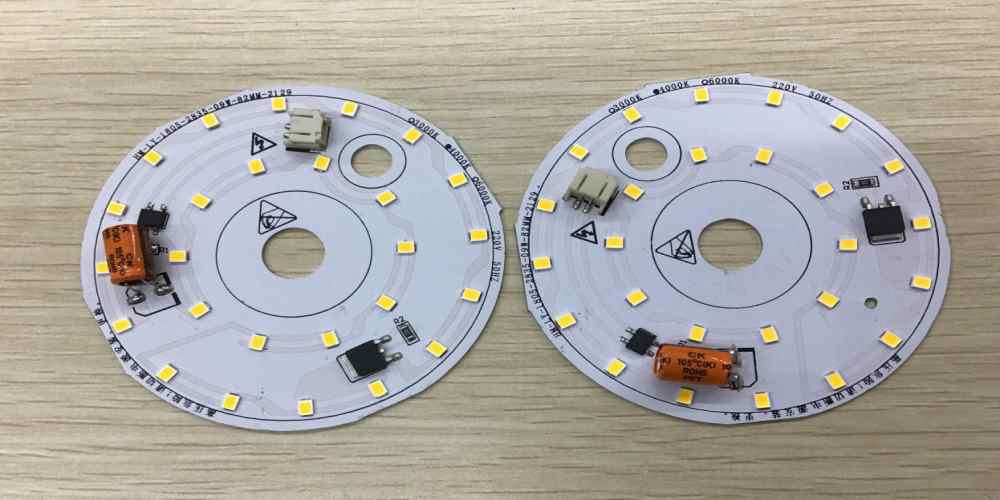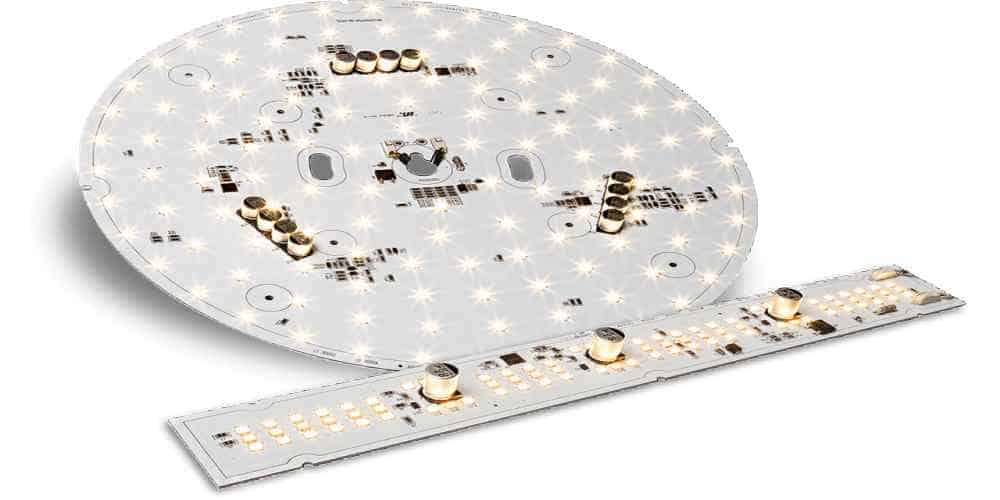Light Emitting Diodes (LEDs) now use some elements of the Printed Circuit Board (PCB). It has become a common practice to integrate the DOB LED PCB into such systems.
This article explains the reason for this, and covers some of the design iterations involved in the process.

What is DOB LED PCB?
It is a type of design process or option for the Light Emitting Diode (LED) systems. The integration is borne out of the need to make circuit boards compatible with LED devices, while expanding the latter’s use cases.
It is to be mentioned that the integration also has additional impacts on the LED systems, in terms of reducing the systems’ footprints.
Benefits of DOB LED PCB
Wondering if using the Driver-on-Board Aluminum LED PCB is best for your light emitting systems? Here are reasons why it is worth it:
Higher Power Efficiency
Maximizing power or current supply and usage is one benefit of this model. Here, the DOB LED PCB make a direct power supply to the Light Emitting Diode (LED) systems and the Integrated Circuit (IC) chips via the 110V or 220V power utility.
Another power maximization feature is the replacement of the AC/DC power source with only the Alternating Current (AC).
Cost Reduction
Spend less on your Light Emitting Diode (LED) systems when you use the Driver-on-Board (DOB) Printed Circuit Board (PCB) for it.
The cost reduction capabilities are drawn from the remodeled circuit design that doesn’t use the following:
- Transformers
- Electrolytic capacitors and;
- Inductors
With fewer components needed, you can be sure of spending less on the Bill of Materials (BOM) for the LED systems/products.
Current Regulation
DOB LED PCB also goes a great deal of job at regulating the LED products/devices/systems’ current. This is achieved because of the maintenance of the current and voltage flow through the Printed Circuit Board (PCB). This way, the device gets to keep functioning and not forced to go below the rated power/current level.
What is a LED Driver?
DOB LED PCB is derived from the general concept of “LED Driver.” So, what does this driver mean?
A Light Emitting Diode (LED) driver is a dedicated power adjustment electronic device, designed to help control the power or light supply in a LED product.
Why control the light or power when the LED is often seen as “self-sufficient” and could potentially regulate itself? This need is necessitated by the fact that the conventional LED IC is susceptible to the following:
- Narrowed current range of the power supply, due to the conduction properties of the LED PN junction.
- An increased likelihood of burnt chip, reduced luminous efficiency and shortened lifespan, due to the slight deviation in the power supply.
- Besides, the conventional LED light source has big volume, which often translates to automation and standardization inconveniences.
How Does It Work?

The Driver-on-Board (DOB) LED PCB works by integrating the LED driver on the circuit board used for making LED products. That way, it is possible to make the needed changes, power conversions and streamline the current on the products.
The driver also works by protecting the LED products against power-induced issues, such as high-power supply/overvoltage and mishaps caused by higher temperatures.
The versatility of the LED products across different applications makes it almost impossible to determine how they get to work across these applications. By using the DOB LED PCB, it is a lot easier to regulate and coordinate the LED devices to work effectively, under the current state or best voltage.
Do I Need LED Drivers?
Is there any need for you to get the DOB LED PCB for your LED products? You may want to consider this if you are producing devices that use lower voltages. The reason for this is that low-voltage LED devices are often susceptible to unpredicted changes in the power supply, which, in turn, hampers the performance.
By integrating the LED drivers in these devices, they get to perform well. For example, a 60V LED device needs the driver to be able to change to the best voltage or switch to the current state when necessary.
Methods in DOB LED PCB Driving
There are four (4) common driving methods and typologies of the LED drivers. They include:
Constant Voltage
This has to do with the sourcing of several constant current sources. The goal is to enable an individual supply of current to the Light Emitting Diode (LED) from each of the current sources.
This method also assures of flexible current sourcing and application, due to the individualization. Thus, the failure of one of the current sources doesn’t necessarily have to limit the power supply from the other sources.
Constant Current
This is the opposite of the constant voltage, in the sense that rather than using individualized current sources, it supplies power in parallel or in series.
The primary benefit to this method is that it helps save costs, unlike the slightly higher cost obtained from the constant voltage.
However, the flexibility and excellence are in doubt, as the parallel design encourages the intertwining of the current sources.
Dimmable LED Drivers
This type of LED drivers allows for the lights to be dimmed. The dimming of the constant voltage LEDs is also achievable via the significant reduction of the amount of current going into the Light Emitting Diode (LED) bulb.
AC LED Drivers
These are the ideal drivers for LED devices having lower voltages. The downside is that these are classified as no-minimum load transformers, due to the inability to detect lower voltages.
The other types of LED drivers are based on the structure of the Printed Circuit Board (PCB). They are:
- Transformer Step-Down Method: this has to do with the conventional transformer method of stepping down the power supply. The downside to this is that it has 60% maximum power efficiency, offers both heavy and small power supply and has low reliability.
- RCC Step-Down Switching Power Supply: this offers a higher power supply efficiency, up to 80%. While the voltage regulation range is relatively wide, its adaptability to normal loads is poor. It also has a number of other negative features, including uncontrollable switching frequency, due to the non-continuous design of the oscillation frequency.
- Resistor Step-Down Method: this has low reliability, and low power supply efficiency due to the larger energy consumption.
DOB LED PCB Selection Criteria

Choosing the right LED driver can be a herculean task, considering that you are looking for the one that covers the power supply, current regulation/distribution and overvoltage protection in one.
Nevertheless, you can pick the best DOB LED PCB if you use some of the following criteria:
1. Safety Considerations
How safe is it to use the LED driver? The IP rating is one factor that helps you determine the type and extent of the safety. For example, if the DOB LED PCB has an IP67 rating, it implies that it is water-resistant and safe from dust.
The UL Classes also have a role to play. The UL Class 1, for example, shows the capability of the LED driver to accommodate more LEDs, while being optimized for use with the high-voltage output applications.
On the other hand, the UL Class 2 offers a safer perspective to protecting the circuits and devices. This is because of the compliance with the UL130 standard and the non-required safety precautions at the LED level.
2. The Dimming Capabilities
Can the LED driver dim the lights of the devices? The Direct Current (DC) dimming capabilities help in changing the devices’ brightness.
3. Power Factor
The power factor of the DOB LED PCB has a way of improving and balancing the LED driver’s efficiency. This is obtainable because of the deduction of the power load of the driver placed on the electrical network.
To get the highest efficiency, consider going for the driver that has a power factor closer to 0.9 and 1.
4. The Input Power
This has to do with the overall efficiency of the LED driver. It works by expressing how much of input power the LED driver would need to power the LED devices.
For the best results, go for the DOB LED PCB with an input power rating of 80% to 85%.
5. Voltage Matching
To avoid making a mistake, go for the LED driver that matches the voltage of the device. For example, a 30V LED device needs to align with a 30V LED driver.
The wattage should also be considered. The goal here is to get a LED driver with a higher (maximum) wattage, as that helps in balancing the performance of the LED’s wattage.
Serious consideration should be made for the type of voltages to use. For example, while it may be ideal to use both the voltage and current ranges in accessing the voltage for constant current LED driver, it is best to stick to only the voltage range for the constant voltage LED driver.
Final Words
LED drivers, such as DOB LED PCB, help in keeping and stabilizing the current or power supply in Light Emitting Diodes (LEDs), especially when there are inconsistencies/fluctuations in the voltage and current.
You need a professional DOB LED PCB company like Hillman Curtis to integrate these drivers into the lights. That way, the fluctuations would be well-managed, and at the same time, the chances of damaging the devices due to higher temperatures would be greatly reduced.

